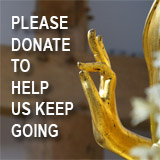From the refugees' stories, a fuller picture is emerging of how a peaceful and apolitical movement by Burma's revered Buddhist monks morphed into the most serious challenge to the junta in two decades. After at least tacitly allowing the demonstrations to take place, the government launched its crackdown when a banned student group and the country's largest opposition party openly joined in and hoisted their banners.
The refugees also offered first-person accounts of seeing unarmed protesters shot and killed. These accounts could not be independently verified, and Burma, which the generals call Myanmar, remains largely closed to foreign journalists. The government has yet to give a full accounting of recent events.
The monks had planned for the demonstrations to last nine days, from Sept. 18 -- nine being a special number in Buddhist tradition. And they had planned for their protests to be peaceful, according to Ashin Kovida and another new refugee here, U Pan Cha, a businessman who managed security for the Rangoon demonstrations.
Pan Cha, who was seasoned in protest during Burma's student uprising in 1988, said in an interview here that when last month's protests began, he held a regular nightly meeting with a Rangoon government official to outline the next day's plans and guarantee security. Pan Cha said the official did not try to stop the demonstrations but told him only that the marches must remain peaceful.
Pan Cha's version of events also seemed to conform with widespread reports at the time that a battle-hardened Burmese army unit was moved into Rangoon to put down the protests. Pan Cha said that on the second day of the protests, he saw soldiers clapping as the procession passed their post. He said he learned that night that Senior Gen. Than Shwe, head of the junta, had issued an order to shoot the protesters but that the local official said he would not follow the order. On Sept. 26, Pan Cha said, he received word that a different army unit, from the 66th Division, which for years had battled ethnic minority rebels from Karen state, had been brought to Rangoon. That day, the violence began.
The government has officially confirmed that 10 people were killed in the crackdown against the demonstrations, which were organized by various groups, some loosely affiliated, in different Burmese cities. Pan Cha said he saw snipers shoot and kill six monks directly in front of him at the Shwedagon Pagoda on Sept. 26, and he saw others killed and hundreds beaten and dragged into trucks. "I cannot imagine how many people were hurt," he said. "Blood was like a stream of water" running down the pagoda road.
The Rangoon demonstrations were sparked by the government's violent reaction to a peaceful protest by monks in the central city of Pakokku. They were opposing a government-mandated fuel price increase in August that would be crippling to the poor. But when they began protesting in solidarity with the people, they were beaten by local officials; video of the beatings quickly appeared on the Internet. The monks and many laypeople were shocked by the government's actions.
Pan Cha said he was asked by a monk friend to help with security for planned protests. He met the monks Sept. 17, the day before their first protest, and planned strategy. The monks insisted there be no violence, and Pan Cha agreed.
On Sept. 18, the marches began. Thousands of monks emerged from Shwedagon Pagoda about 1 p.m., chanting a Buddhist mantra for peace and loving kindness. It was raining. Passersby stopped and prayed with the monks. Soon, many joined the march. Pan Cha asked them to join hands and walk outside the monks, forming a kind of protective chain.
Ashin Kovida was one of the march organizers. He said he knew the people would join the monks, so he routed the marches from Shwedagon Pagoda to Sule Pagoda -- the two most prominent temples in Rangoon -- because their busy streets meant that many people would see what was happening.
For several days, the marches met no government resistance. They grew in numbers.
On Sept. 22, the monks and their supporters won a key symbolic victory. They were allowed to march past the home of Aung San Suu Kyi, the opposition party leader under house arrest. Pan Cha had outlined the plan to march past her house in his regular nightly meeting with the government official. When the marchers arrived at University Avenue, where the Nobel Peace laureate's house is located, an army captain let them pass after conferring on the phone and with other officers and police on the scene.
"I was so happy I cried," Pan Cha said, his voice rising as he recalled the moment. "All the world leaders who want to meet with her and are not allowed, but we are allowed to meet. We could make the world know the Burmese people showed unity in support of Suu Kyi."
At this point, the marches were becoming more political. On Sept. 23, Pan Cha discussed with the monks a request by the All-Burma Federation of Student Unions, a government-banned group that had been marching with the monks but not officially declaring its presence. Now the students wanted to hold their banner when they marched. The monks decided to allow the students to hold the sign starting on Sept. 24, and members of Suu Kyi's National League for Democracy party were also allowed to hold signs.
The decision caused a subtle shift in the character of the demonstrations, Pan Cha said. "The main protesting before was for the country and for respecting religion, not for politics," he said.
The next two days of marches were peaceful, but when Pan Cha went to meet his contact the night of Sept. 25, the government official did not show up. Pan Cha, suspicious, called a meeting of the monks. "I told them we have to be cautious tomorrow," he said.
The violence began Sept. 26. Army troops from the regiment newly arrived from outside Rangoon, as well as police, surrounded the monks who had gathered at Shwedagon Pagoda to start their march. All four corners of the pagoda grounds were blocked.
A group of monks sat down in an attempt to begin negotiations to defuse the situation. "They started to pray, but the police just started beating them," Pan Cha said. Instantly, 50 to 100 police officers jumped from hiding places wielding wooden batons. A loudspeaker started blaring, telling people to go away. But there was nowhere to run; soldiers and police blocked all the exits.
Ashin Kovida felt the blow to his belly before he saw the stick coming. He was one of the seated monks and had raised his praying hands to his forehead as he chanted the Buddhist mantra for peace. As he doubled over from the blow, he saw novice monks trying to scramble up a high wall behind them. "People were trying to escape by climbing that wall, but the police were pulling them down and kicking them, even a girl."
Next, Ashin Kovida felt the tear gas. "I wondered if I might die when I was being beaten," he said. "I had never seen anything like that before." He ran to the wall and climbed over, dropping onto the ground at his Nan Oo monastery, next door to the pagoda. He and others climbed the wall on the other side and saw masses of people, their way into the pagoda complex blocked by troops. He called to them to turn and walk the other way, into the street and toward Sule Pagoda. He soon had a group of about 1,000 following him.
Ashin Kovida did not reach Sule Pagoda. Too many roads were blocked. He decided to go home to his monastery, a small one that had not yet been raided by police.
Pan Cha, meanwhile, tried to march a group to the Chinese Embassy to protest the bloodshed, but the roads were blocked. Police started beating the protesters and dragging them to trucks. Pan Cha was pulled into a house by people trying to protect him. They gave him clean clothes and took his bloodstained ones, then took him behind the house and helped him escape.
The next day, Ashin Kovida got on a bus with other monks, looking for a place clear of government troops to start marching. As they were making their way to Sule Pagoda, a friend called to tell him to avoid Sule; government forces were again shooting people.
He headed back to his monastery, but he and the other monks were afraid that it was only a matter of time before soldiers raided it, too. Ashin Kovida found a hiding place, where he stayed until Oct. 12. He heard that police had his photo and were hunting him. The government newspaper published his name in a list of 20 monk leaders who were "making the country unstable."
"It was getting worse and worse," he said. "But I didn't know where to go. I didn't have any connection outside of Burma."
After fleeing his safe house Oct. 12, Ashin Kovida found a new place and started preparing to leave the country. He dyed his hair, exchanged his robe for a longyi and obtained a fake ID.
The next morning, he crossed into Thailand by boat and hired a motorbike to take him to Mae Sot. Later, he was somewhat amused to learn that he had been cheated by the driver, who charged him double the usual rate.
Ashin Kovida is not sure what he will do next. He knows he wants to keep working in the movement for democracy in Burma. He knows he wants to remain a monk.
He worries about the woman he calls his adoptive mother and her two daughters, ages 5 and 10. He does not know what happened to them, but said, "Because of me, she was arrested."
Of the 15 monks who were part of his leadership group, he has heard that eight have been arrested and six are in hiding. The government is still trying to find him. On Oct. 18, the junta's newspaper published an article linking Ashin Kovida to the discovery of a small stash of TNT.
"Because the monks' peaceful demonstrations got international support and the support of the people of Burma, the government does not know how to take more actions against the monks," he said. "So they are trying to say monks are going to use violence. If they take action against the monks without telling a story, it's not good in the international community."





